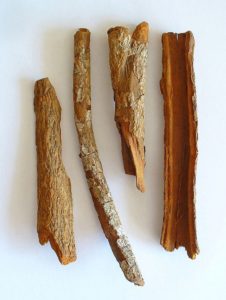Chinchona bark is best known as the source of the anti-malarial drug quinine and is now cultivated throughout the tropics, including regions of Africa.
Contents
Uses
The bark is medicinally active, containing a variety of alkaloids including the antimalarial compound quinine and the antiarrhythmic quinidine. Although the use of the bark has been largely superseded by more effective modern medicines, cinchona is the only economically practical source of quinine, a drug that is still recommended for the treatment of malaria.
Benefits
Cinchona is used for increasing appetite; promoting the release of digestive juices; and treating bloating, fullness, and other stomach problems. It is also used for blood vessel disorders including hemorrhoids, varicose veins, and leg cramps. Some people use cinchona for mild attacks of influenza, swine flu, the common cold, malaria, and fever. Other uses are for cancer, mouth and throat diseases, enlarged spleen, and muscle cramps.
Cinchona is used in eye lotions to numb pain, kill germs, and as an astringent. Cinchona extract is also applied to the skin for hemorrhoids, stimulating hair growth, and managing varicose veins.
Cautions
Cinchona bark seems to be safe for most people when used appropriately. However, in large amounts, cinchona is UNSAFE and can be deadly. Symptoms of overdose include ringing of the ears, headache, nausea, diarrhea, and vision disturbances. Cinchona can also cause bleeding and allergic reactions, including hives and fever.
Special Precautions & Warnings:
Pregnancy and breast-feeding: Don’t use cinchona if you are pregnant or breast-feeding. There is some evidence that cinchona is UNSAFE to use during pregnancy. Not much is known about the safety of using cinchona if you are breast-feeding, so it’s best to avoid it.
Stomach or intestinal ulcers: Don’t use cinchona if you have ulcers. It might increase the risk of bleeding.
Surgery: Cinchona can slow blood clotting, so there is a concern that it might increase the risk of extra bleeding during and after surgery. Stop using cinchona at least 2 weeks before a scheduled surgery.
Other Names
Bois aux Fièvres, Cinchona calisaya, Cinchona carabayensis, Cinchona ledgeriana, Cinchona officinalis, Cinchona pubescens, Cinchona succirubra, Chinarinde, Cinchonine, Écorce du Pérou, Écorce de Quina, Écorce de Quinquina Rouge, Fieberrinde, Jesuit’s Bark, Kina-Kina, Peruvian Bark, Poudre des Jésuites, Quina, Quinine, Quino, Quinquina, Quinquina Gris, Quinquina Rouge, Red Cinchona Bark
References
Source: WebMD, http://www.webmd.com/vitamins-supplements/ingredientmono-406-cinchona.aspx?activeingredientid=406&activeingredientname=cinchona
Wikipedia, https://en.wikipedia.org/wiki/Cinchona
Herbal Supplement, https://www.herbal-supplement-resource.com/cinchona-bark.html

